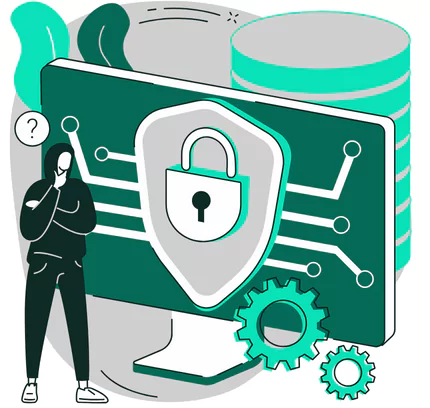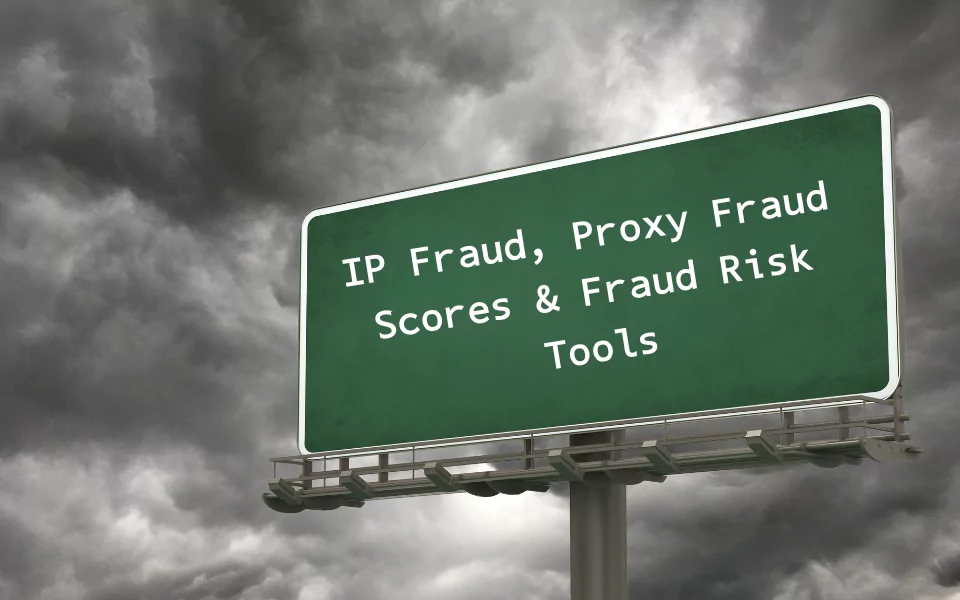If you want to prevent your online operations from falling prey to IP fraud, you can take some precautionary steps and verify that there isn’t any previous IP fraud risk with your new IP proxy. In this simple guide, we will present what IP fraud is, its relation to proxies, and provide some insights about proven strategies to minimize the risk of IP fraud. We will also discuss 13 tools you can use to detect and minimize IP fraud risk.
Table of Contents
- The Growing Risk of IP Fraud
- Evolving Fraud Techniques And The Role Of Proxies
- Understanding IP Fraud Scores
- Parameters and Data Points Used In IP Fraud Score Calculation
- What Do 0 Fraud Proxies Mean?
- Types of Proxies and Their Impact On IP Fraud Scores
- How To Avoid IP Fraud Risks?
- Advanced IP Fraud Detection Techniques
- 12 Advanced Free IP Fraud Detection Tools
- Main Takeaways
- References and Additional Resources
The Growing Risk of IP Fraud
As a zero-fraud proxy provider, V6proxies considers IP fraud a red line. It’s essential to understand the landscape of IP fraud and its implications. Fraudsters, increasingly adept with technology, often misuse proxies to hide their real locations. This allows them to undertake illicit activities while remaining undetected.
The risks are substantial. Businesses relying on compromised proxies can face severe consequences, including financial losses and reputational damage. More critically, the misuse of proxies in IP fraud can lead to the endangerment of personal data, escalating to identity theft and other serious privacy violations.
Practical Example: Imagine a scenario where a business unknowingly uses a compromised proxy. This can lead to data breaches, and IP banning leading to failure and legal issues. Conversely, utilizing a zero-fraud proxy provider could prevent such incidents, ensuring safer digital transactions.
Fact: Data from a 2023 cybersecurity study shows that 48% of organizations reported an increase in cyberattacks compared to the previous year
Evolving Fraud Techniques And The Role Of Proxies
As cybercriminals keep honing their tactics, the demand for trustworthy proxies becomes higher. Fraudsters utilize a range of advanced strategies, including:
- Refined malware
- Sophisticated phishing scams
- And cunning social engineering approaches
- They’re also harnessing the power of emerging technologies like AI to circumvent traditional safety measures.
Through proxies, these fraudsters can mask their real IP addresses, making it tough to track their malicious deeds. Their concealed digital footprint allows them to perpetrate various harmful activities, ranging from data theft to financial scam, under the radar. This means some IPs offered by proxy providers can be those used in fraud before you buy them.
That’s why opting for a zero-fraud proxy service is crucial for anyone wanting to maintain the utmost online security and integrity. These dependable proxies guarantee that the IPs you use are not banned or flagged as fraud.

Understanding IP Fraud Scores
IP fraud scores, also known as ‘fraud probability’, are numerical values assigned to IP addresses based on their potential risk of being involved in online fraud. This methodology is utilized by anti-fraud systems such as SEON.io and Riskified to evaluate the trustworthy nature of an IP address. But, how does the scoring work?
The process of calculating an IP fraud score involves a blend of data analysis, predictive algorithms, and machine learning. During this process, a range of parameters and data points are assessed. These could include factors like the type of proxy used, the geolocation of the IP, the internet service provider (ISP) associated with the IP, and its historical behavior.
Note: An IP address with a high fraud score doesn’t necessarily mean it is fraudulent. It simply indicates that the associated IP has exhibited characteristics that often align with fraudulent activities, making it potentially risky.
Parameters and Data Points Used In IP Fraud Score Calculation
These parameters used to calculate fraud include:
- The type of proxy used: Certain types of proxies such as HTTP proxies and SOCKS proxies can easily mask a user’s original IP address, thereby increasing the risk impact the calculator result shows.
- Public vs. Private IP Addresses: Generally, private IP addresses are more trustworthy as they are assigned to specific devices in a private network. In contrast, public IPs are accessible over the internet, making them more susceptible to fraudulent activities.
- The geolocation of the IP: If an IP address is associated with a geographic location known for high cybercrime rates, this can heighten its fraud score.
- The ISP associated with the IP: Some ISPs have higher incidences of fraudulent activity than others. Thus, an IP address associated with such an ISP might have a higher fraud probability.
- Historical behavior: If an IP address has previously been linked with fraudulent behaviors, its fraud score is likely to be high.
- IP Analytics: IP Analytics is a broad field that involves assessing IP-related data in real-time to detect any signs of IP address manipulation. Key indicators like multiple transactions originating from the same IP address, abrupt changes in geolocation, or sudden switch from a private to a public IP are all red flags suggesting potential fraud.
- Blacklisting: If an IP is previously flagged for suspicious activities or is on a blacklist, it tends to receive a high fraud score.
- Device Information: The operating system and browser of the device using the IP address are factors in fraud score calculation.
- VPN and Emulator Use: The use of tools like VPNs and emulators, which can hide or alter IP information, affects the fraud score. For instance, using a VPN might add points to the fraud score, indicating higher risk.
Example:
In an anti-fraud system, IP fraud scores are usually presented as a numerical value between 0 and 100. A low score, closer to zero, indicates a low probability of fraud, whilst a high score, closer to 100, implies a higher risk. Public and enterprise anti-fraud mechanisms may use slightly different scoring systems, however, the principle stays the same – higher scores represent a greater level of risk.
For example, an IP address with a geolocation in Canada may add to the IP fraud score +4. Further, the type of proxy adds +1. However, the historical usage of this IP has low incidents of IP fraud which subtract -2. Finally, the ISP that this IP is associated with is proven to be secured and run a good IP fraud detection system subtract -2. The total IP fraud score (+4+1-2-2=1) which indicates a low IP fraud risk.
What Do 0 Fraud Proxies Mean?
When people talk about 0 Fraud Proxies, they’re referring to proxies that have been determined to have a zero score in terms of fraud potential. Essentially, these are IP addresses completely devoid of any dubious activities or characteristics typically associated with fraudulent behavior.
Types of Proxies and Their Impact On IP Fraud Scores
There are numerous kinds of proxies, each with its unique set of features that can influence IP fraud scores. Let’s see the effect of the most common proxy types and examine their potential impact on IP fraud detection.
1- The Hypertext Transfer Protocol (HTTP) proxy is the most widespread type. It operates at the application layer of the OSI model (Open Systems Interconnection), functioning primarily to process web traffic. An HTTP proxy can mask the user’s real IP address, providing a level of anonymity while surfing the web. However, they might indirectly affect the accuracy of IP fraud scores, as fraud-detection systems may view these disguised IPs with increased suspicion.
2- Activate Proxy Detection Techniques. Using advanced proxy detection techniques is a useful strategy in detecting IP fraud. Activate technologies like IPQualityScore’s proprietary tracking to identify suspicious proxy use.
3- Customize Scoring Settings and API Inputs. While pre-set scoring settings may offer a good starting point, customizing these settings to suit your specific needs can immensely enhance detection accuracy. The same applies to API inputs. Be proactive and fine-tune scores based on your business specifics.
How To Avoid IP Fraud Risks?
IP fraud poses a significant risk to the online ecosystem. As such, adopting effective strategies for IP fraud detection is critical for safeguarding your online enterprise. Some of the best practices you can consider to mitigate IP fraud risk effectively include:
1- Using Comprehensive IP Fraud Risk Assessment Tools. One of the primary steps toward controlling IP fraud is utilizing well-rounded risk assessment tools. Employ tools like Riskified and IPQualityScore, which give an extensive assessment of the risk associated with an IP address. These tools use several parameters to calculate risk, thereby providing you with a more complete and accurate analysis.
2- Deploy Real-time IP Analysis. Don’t wait for a fraudulent activity to affect your business before catching it. Instead, use real-time IP analysis tools. These tools can monitor IP addresses in real-time and immediately alert you to potential fraud risks, enabling you to act swiftly.
3- Activate Proxy Detection Techniques. Using advanced proxy detection techniques is a useful strategy in detecting IP fraud. Activate technologies like IPQualityScore’s proprietary tracking to identify suspicious proxy use.
4- Customize Scoring Settings and API Inputs. While pre-set scoring settings may offer a good starting point, customizing these settings to suit your specific needs can immensely enhance detection accuracy. The same applies to API inputs. Be proactive and fine-tune scores based on your business specifics.

Advanced IP Fraud Detection Techniques
Advanced techniques and tools have been developed to detect proxies and VPNs, further enhancing the capabilities of IP fraud detection. These techniques come in handy to reduce false positives, thereby increasing detection accuracy.
- Machine Learning and AI in Proxy Detection. In recent years, machine learning and AI have shown promise in improving proxy detection methods. AI-powered software and algorithms can analyze large amounts of data and detect patterns that might be missed by traditional methods. They help in accurately identifying proxies, taking into account various parameters like response time, geolocation inconsistencies, and patterns of suspicious activities.
- Behavioral analysis is another noteworthy technique where user behavior patterns are scrutinized for any signs of manipulation and automation. This typically includes monitoring repetitive actions, rapid sequences of clicks, or abnormal navigation flows which might signal bot activity conducted via anonymization tools like proxies or VPNs.
- Device fingerprinting is a method used to identify users based on specific attributes of their devices such as the browser and OS, screen resolution, and installed fonts. Fingerprinting can sometimes help in uncovering proxy usage, especially if the device attributes and IP location data don’t line up logically.
- Threat Intelligence Platforms collect and analyze data about current and potential threats across the web. They can identify IP addresses associated with known proxies or VPNs, by referencing large databases of blacklisted or suspicious IPs.

12 Advanced Free IP Fraud Detection Tools
1- SEON: Offers granular and customizable fraud detection, including device fingerprinting and digital profiling. It provides real-time IP analysis and machine learning algorithms for continuous adaptation. However, it lacks on-site integration and identity document verification checks.
2- Sift: Specializes in digital trust and safety, integrating well with existing systems. Sift uses machine learning to reduce false positives and focuses on preventing account takeover. It has a strong enterprise focus but lacks real-time social media checks and AML capabilities.
3- ComplyAdvantage: Focuses on API-based KYC and AML, with transaction monitoring and customer screening using sanction and PEP lists. It’s notable for its free version, although it doesn’t offer data enrichment.
4- IPQualityScore: Specializes in IP-based fraud detection, offering real-time analysis and scoring based on IP information
5- ThreatMetrix: Acquired by LexisNexis Risk Solutions, it offers fraud prevention for various industries with a large IP database and graph visualization tools. It provides on-premise deployment but requires additional costs for data enrichment.
6- Kount: An enterprise-grade fraud detection tool with a broad focus on retail e-commerce. It offers automated and customizable rules but has limited machine learning capabilities and lacks data enrichment.
7- Signifyd: Geared towards merchants, it offers automated chargeback prevention and is PSD2 compliant. However, it does not provide real-time data and may have a conflict of interest in certain scenarios.
8- Emailage: Specializes in reverse email lookup, offering real-time alerts and integration with LexisNexis. However, it lacks sufficient real-time data and device fingerprinting capabilities.
9- ArkOwl: Provides live data enrichment from various sources including social networking sites and WHOIS databases. The tool has a flexible pricing but may not be suitable for all fraud challenges.
10- Ekata: Part of the Mastercard Group, it offers global identity verification and fraud prevention with expansive databases and graph visualization. However, it is primarily US-centric and optimized for specific software stacks.
11- TruValidate (formerly Iovation): Provides device and IP intelligence for fraud analytics and authentication. It is part of the TransUnion ecosystem but may use stale data and lacks real-time data enrichment.
12- FraudHunt: Targets emerging markets with affordable fraud prevention, focusing on device fingerprinting. It offers competitive pricing and accessibility but has limited native analytics and is not optimal for scaled businesses
13- Accertify: An American Express company offering a comprehensive fraud solution from customer authentication to chargeback management. It uses machine learning for digital identity insights but lacks social media enrichment and focuses mainly on enterprise-level clients.
Best Practices for Using Advanced IP Fraud Detection Techniques
- Keep your threat intelligence data up-to-date for accurate detection of blacklisted proxies or VPNs.
- Implement behavior-based anomaly detection to spot suspicious activities quickly.
- Integrate machine learning and AI capabilities into your existing systems to enhance detection capabilities.
- Tune your parameters frequently for better alignment with evolving fraud patterns.
What Does It Mean When A Website Says IP Has Been Logged For Fraud Protection?
It simply indicates the site is tracking activities to safeguard its service, users, and data from any fraudulent actions. If your IP address gets involved in suspicious behavior or breaches the terms of service, it’ll be flagged for a thorough review. Depending on the severity of any associated violations – from minor offenses to serious infractions like fraudulent transactions or privacy breaches – the consequences can range from receiving a warning to suspension of your account, or even reporting to legal authorities.
As a user, as long as your online activities adhere to the website’s terms of service, this security measure should pose no concern.
Main Takeaways
- Fraudsters increasingly use advanced tactics, including proxies, to hide their true locations and engage in illicit activities undetected.
- Utilizing compromised proxies can lead to significant business risks, including financial losses, reputational damage, and the potential compromise of personal data.
- Choosing zero-fraud proxy services is crucial to ensure that the IPs used are free from past fraudulent activities, thus maintaining online security and integrity.
- IP fraud scores, calculated using data analysis and machine learning, assess the risk associated with an IP address based on factors like proxy type, geolocation, ISP, and historical behavior.
- Tools like SEON, Sift, and IP Quality Score provide comprehensive, real-time analysis to effectively detect and prevent IP fraud, using techniques like device fingerprinting, digital profiling, and machine learning algorithms.
References and Additional Resources
- IP fraud costs businesses an estimated $5.8 billion annually.
- Over 50% of all online fraud attempts are related to IP fraud.
- Proxy usage has increased by 300% in the past five years.
- IP fraudsters often target industries such as finance, gaming, and online marketplaces.
Related Articles
- What to do if an IP Address is Exposed, Leaked or Hacked?
- What is an IP Address? Simple facts for beginners
- Can YouTube Detect Bot Views? (If Yes, Consequences?)
- Buy Craigslist Proxies | Residential IPs (Post & Unblock)
Related posts:
- Tags:
- Cybersecurity Advice

